The Old City of Dubrovnik is situated on a small peninsula surrounded by the Adriatic Sea. Dubrovnik was once part of the Byzantine Empire. During the Middle Ages, Dubrovnik was dominated by Venice and Hungary, it became part of Austria in the 19th century. After the First World War, the city became part of former Yugoslavia. Nowadays, Dubrovnik is a city in Croatia. Dubrovnik is renowned for its defensive city walls and fortresses. The city walls of the Old City of Dubrovnik were built in the 10th and 13th century. The city walls surround most of the old city, they are considered the most complete in Europe. The Minceta Tower is the highest point on the city walls and the symbol of the unconquerable city of Dubrovnik. Dubrovnik was heavily damaged during the Croatian War of Independence (1991-1995). After the war, the city has been restored to its former beauty. Dubrovnik is also known as the 'Pearl of the Adriatic'. The City of Dubrovnik is located on the Dalmatian coast in Croatia. The Old City of Dubrovnik gained the status as a UNESCO World Heritage in 1979.
www.werelderfgoedfotos.nl © Copyright World Heritage Photos
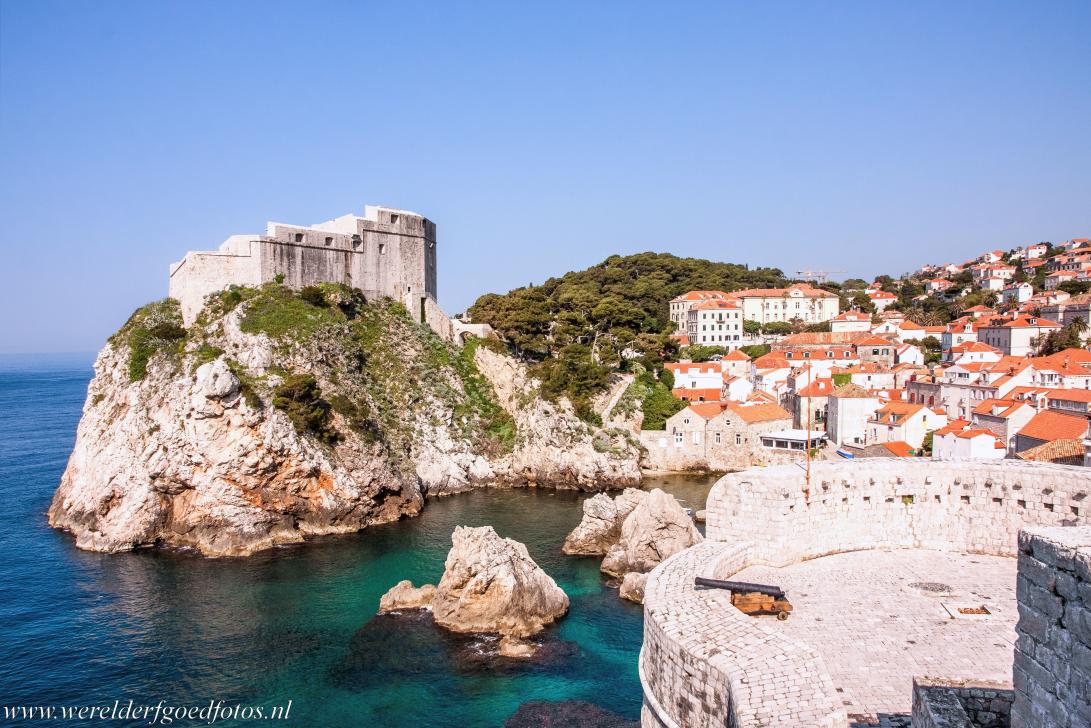
Old City of Dubrovnik: The St. Lawrence Fortress or Lovrijenac (on the left hand side) was built in the 11th century. Fort Bokar (on the right hand side) is probably the oldest casemented fortress in Europe. Fort Bokar was built in 1461-1463 and is the keypoint in the defense of the Pile Gate. The Old City of Dubrovnik was inscribed on the UNESCO World Heritage List in 1979.

Old City of Dubrovnik: The St. Lawrence Fortress or Lovrijenac (on the left hand side) was built in the 11th century. Fort Bokar (on the right hand side) is probably the oldest casemented fortress in Europe. Fort Bokar was built in 1461-1463 and is the keypoint in the defense of the Pile Gate. The Old City of Dubrovnik was inscribed on the UNESCO World Heritage List in 1979.
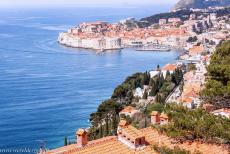
The Old City of Dubrovnik is situated on a small peninsula surrounded by the Adriatic Sea. The seaside walls of Dubrovnik are much smaller than the walls on the landside because the seaside is also protected by high cliffs. The walls form an unbroken circle around the old city, they have a length of about 1,940 metres.
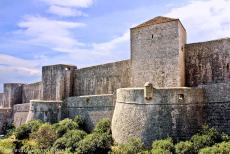
The Old City of Dubrovnik is completely surrounded by defensive walls and fortresses. The city walls of Dubrovnik were built in the 10th and 13th centuries. The walls reach a height of about 25 metres. The city walls of Dubrovnik are considered one of the most complete in Europe. The Old City of Dubrovnik was declared a UNESCO World Heritage in 1979.
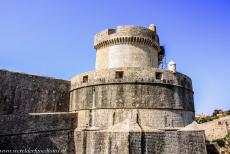
Old City of Dubrovnik: The Minceta Tower was built in 1463. The tower is the highest point on the walls of the Old City of Dubrovnik, the impressive tower is the symbol of the unconquerable city of Dubrovnik. The old city is entirely surrounded by medieval defensive walls and forts. It is possible to take a stroll atop the entire length of the walls and climb the Minceta Tower.
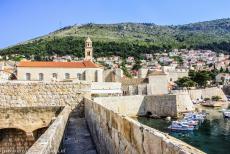
Old City of Dubrovnik: The defensive city walls, the Dominican Monastery and Revelin Fortress. The Dominican Monastery lies behind the city walls of Dubrovnik, the Dominican Monastery was restored after a heavy earthquake in 1667. The 14th century monastery church holds one of the largest painted crucifixes in Europe, it is about five metres tall.
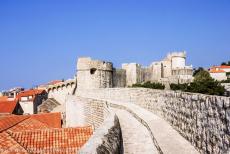
The defensive stone walls of the Old City of Dubrovnik. Dubrovnik was heavily damaged during the Croatian War of Independence (1991-1995), little of Dubrovnik was left untouched. After the war, the intensive restoration works of the Old City of Dubrovnik took several years. Walking on the walls of Dubrovnik, you can see a few old roofs from before the war and a huge number of new roofs from after the war.
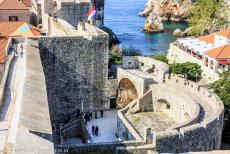
Old City of Dubrovnik: The fortified complex of the Pile Gate, the gate is the principal city gate of the walled city of Dubrovnik. The gate was defended by Fort Bokar and a dry moat, the Pile Gate consists of two separate city gates, an outer gate and an inner gate, built in 1460. The imposing gate was used as a film location for the film series the Game of Thrones.
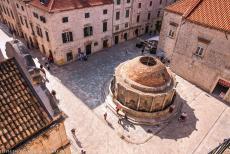
Old City of Dubrovnik: The Big Fountain of Onofrio viewed from the city walls of Dubrovnik. The Big Fountain of Onofrio was built between 1438 and 1444. The fountain is part the water supply system of Dubrovnik. The fountain stands in front of the St. Saviour Church. The entrance to the city walls of the Old City of Dubrovnik is next to the St. Saviour Church.
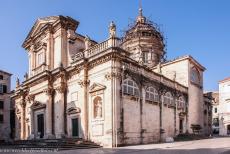
Old City of Dubrovnik: The Dubrovnik Cathedral of the Assumption of the Virgin Mary replaced an older cathedral that was completely destroyed by a ruinous earthquake in 1667. The present cathedral was completed in 1713. It houses several important religious paintings, the main altar holds a work by the Renaissance painter Titian, a version of the 'Assumption of the Virgin Mary'.
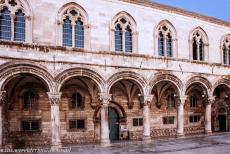
Old City of Dubrovnik: The 15th century Rector's Palace was the main residence of the Rector of the Republic of Dubrovnik. Later, it housed an armoury, a powder magazine, a watch house and a prison. It was built in the Gothic style, but later decorated with Renaissance and Baroque style elements. Nowadays, the Rector's Palace houses a museum. It is sutuated on the Luža Square.
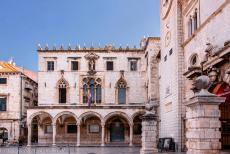
Old City of Dubrovnik: The 16th century Sponza Palace was a customs house and a warehouse. The palace remained in public use until the 19th century. It survived the disastrous earthquake of 1667. The Clock Tower of Dubrovnik stands next to the Sponza Palace, the tower was rebuilt in 1928, but it houses the original bell (2000 kg) from the original 15th century tower.
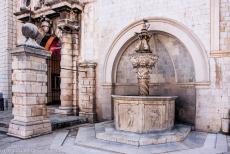
Old City of Dubrovnik: The Small Onofrio's Fountain was built in 1441. The fountain is located on the Luža Square next to the Clock Tower of Dubrovnik. The fountain is part of the water supply system of Dubrovnik. The Small Onofrio's Fountain is situated at the eastern end of the Stradun, the 300 metres long main street of the Old City of Dubrovnik.
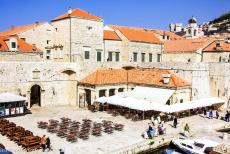
Old City of Dubrovnik: The Fish Market and the Fish Market Gate are situated at the Old Port of Dubrovnik. The Fish Market Gate was built in 1381. The historic Fish Market was damaged by an earthquake in 1979 and once again during the Croatian War of Independence (1991-1995). After the war, it was restored. The Old City of Dubrovnik became a UNESCO World Heritage in 1979.
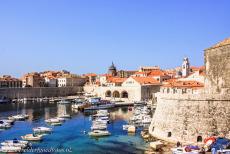
Old City of Dubrovnik: The City Harbour is one of the oldest parts of Dubrovnik. The arsenal with its three arches was built in the 12th century. The Revelin Fortress (on the right hand side) was part of the defence system of the Ploce Gate. The historic city of Dubrovnik is also known as the Pearl of the Adriatic Sea.
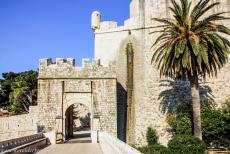
Old City of Dubrovnik: The Ploce Gate is the second major entrance to the city. The Ploce Gate was built on the eastern side of the city in 1628. On the right hand side the Revelin Fortress, the massive fortress was built in 1580 during the period of the Ottoman threat. The city walls of the historic city of Dubrovnik are the most complete in Europe.
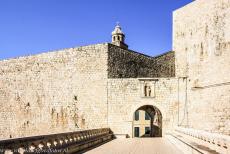
Old City of Dubrovnik: The Ploce Gate consists of two separate gates, an inner gate (photo) and an outer gate, the gates were connected by a stone bridge. During the Middle Ages, Dubrovnik was dominated by Venice and Hungary, in the 19th century it became part of Austria. After WWI, it became part of former Yugoslavia and nowadays, Dubrovnik is a city in Croatia.
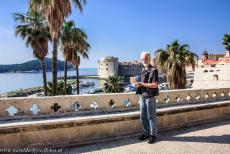
Old City of Dubrovnik: The St. John Fortress viewed from the Ploce Gate bridge, the fortress was built in the 14th century to defend the harbour of Dubrovnik and was modified in the 15th and 16th centuries. Nowadays, the fortress houses the Dubrovnik Maritime Museum. The island of Lokrum on the Adriatic Sea lies in the background.
